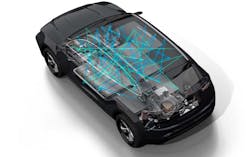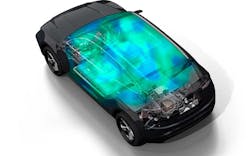Data-Driven Design: Leveraging Synthetic Data for Engineering Simulations
This article appeared in Machine Design and has been published here with permission.
What you'll learn:
- Defining the concepts of synthetic data and digital twins.
- How the two technologies improve synergy in collaborative design efforts.
- Overcoming synthetic-data authenticity challenges with benchmark testing.
In the field of machine design, innovation and efficiency have always been paramount. To achieve these goals, engineers and designers have traditionally relied on physical prototypes, extensive testing and iterative improvements. However, the advent of synthetic data and digital twins is revolutionizing the product design process.
These technologies offer unprecedented opportunities to accelerate development cycles, optimize designs and enhance product performance. Far from suggesting that digital twins and synthetic data are on their own unlocking new potential in design, they are being combined to open new doors and help designers to reach new heights.
What are Synthetic Data and Digital Twins?
Synthetic data refers to artificially generated data that closely resembles real-world information. It is created using algorithms and models that capture the characteristics and patterns of the original data. In product design, synthetic data enables engineers to simulate various scenarios, test different design parameters and generate vast amounts of data without the need for physical prototypes. This approach significantly speeds up the design process, reduces costs and enhances the overall product quality.
Digital twins are virtual representations of physical products, systems or processes. They combine real-time data from sensors, devices and other sources with advanced analytics and modeling techniques to create a dynamic digital replica.
By analyzing and simulating the behavior of a product in a virtual environment, digital twins allow product creatives to optimize performance, predict maintenance requirements and explore design alternatives. They serve as a powerful tool for product development, enabling further improvement and enhancing design decisions.
Widening Design Exploration
The two technologies offer designers the ability to explore design possibilities in a virtual space. This leads to a more comprehensive understanding of the product’s behavior, consequently resulting in a better-informed design. Additionally, digital twins allow designers to observe how changes in design parameters affect performance in real-time, facilitating rapid iteration and optimization.
A key feature in this recent chapter of the digitization of design is that synthetic data and digital twins have dramatically improved collaboration and communication among stakeholders involved in the product design process. Virtual replicas are far easier to share and visualize than their physical counterparts, and the results of these twins being used alongside synthetic data are far-reaching.
Using these technologies gives a much wider scope for cooperation between team members. Digital twins provide a common platform for stakeholders to monitor and analyze product performance, facilitating cross-functional communication and enabling more informed decision-making.
A suitable field that demonstrates this synergy is the electronic audio industry. Many electronics manufacturers employ digital twins in the design of their audio equipment, such as headphones, speakers and microphones. Having created virtual replicas, engineers can then use synthetic data to test the acoustical performance of their products. Acoustic simulation platforms such as Treble can provide synthetic audio data that accurately represents how audio devices will sound within any given environment.
In this instance, digital twins are not only used to replicate the audio device, but also to virtualize any built environment providing engineers with a comprehensive range of simulation scenarios (room size, materials and furnishing density). The resulting synthetic data, which provides a highly authentic listening experience, thus enables the testing, evaluation and optimization of different audio designs and features, all while reducing the need to build a physical prototype.
By harnessing the power of synthetic data and digital twins, developers gain deeper insights into product performance. The aviation industry demonstrates a perfect example of this. As a result of using digital twin technologies, Boeing recently saw a 40% improvement in first-time quality of its systems and parts.
The company took the decision to digitize its entire development system to ensure more efficient services and better value for its clients. Using digital twin replicas of the aircraft, these are then “tested” with synthetic datasets—such as weather conditions and aging—to assess how aircraft parts will cope with these conditions. Modifications can then be made, with a higher confidence in the result, since the quality of the parts has already been tested.
In this scenario, synthetic data provides a comprehensive understanding of the product’s behavior, leading to more accurate predictions of its real-world performance, while digital twins facilitate continuous monitoring, analysis and optimization of product performance throughout its lifecycle. They enable proactive maintenance, early detection of issues and predictive analytics, resulting in improved reliability and reduced downtime.
Traditionally, physical prototyping and testing have also been time-consuming and expensive processes. In the automotive industry, prototypes cost millions to test. Whether on wind tunnels or raw materials, car manufacturers cumulatively spend $10 billion per year on prototypes. Synthetic data and digital twins alleviate these challenges by enabling sophisticated virtual prototyping. Consequently, development cycles are significantly shortened, enabling faster time-to-market and increased competitiveness.
Further highlighting how these technologies are benefiting the automotive industry, NVIDIA has recently generated a digital twin of BMW’s Regensburg factory in Bavaria to plan the production process in greater detail. NVIDIA utilized human-centric synthetic data (essentially digital humans trained with data from real factory workers) to test new workflows and train models for robot movements within the virtual environment.
Using said data, engineers could track any minuscule changes made to one part and the subsequent knock-on effects on sections further down the process. In due course, the factory itself was modified to run a far more efficient production line.
Ensuring Synthetic Data’s Authenticity
While synthetic data and digital twins do offer tremendous potential, they are not without challenges. Generating accurate synthetic datasets that faithfully represent real-world scenarios can be a complex task. It requires sophisticated algorithms and careful calibration to ensure that the synthetic data accurately reflects the characteristics of real data. Creating comprehensive digital twins that capture the complexity of physical systems may require significant computational resources and integration with IoT devices.
At Treble Technologies, acoustic engineers achieve this through benchmark testing. Having successfully simulated a device’s performance in one complex real-life room, the same benchmarks such as geometry detail or boundary conditions can then be used to simulate other hypothetical rooms of similar complexity. To evaluate the authenticity of synthetic data, benchmark datasets comprising real-world data can be created.
These datasets should exactly represent the characteristics and diversity of the data domain under consideration. By subjecting synthetic data to benchmark testing (by comparing the real-world data with the identical synthetic data), organizations can gain confidence in its authenticity and reliability.
Synthetic data and digital twins are transforming the landscape of product design. By enabling virtual prototyping, rapid iteration and performance optimization, these technologies significantly accelerate development cycles and enhance product quality. As we move forward, embracing these technologies will be crucial for designers and engineers striving to stay competitive in an ever-evolving marketplace.



